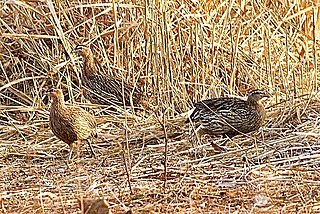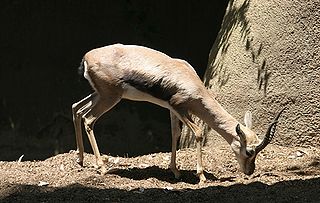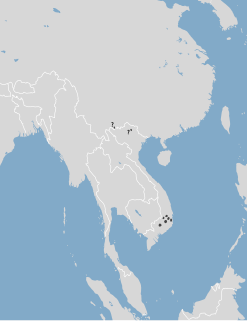
The double-spurred spurfowl is a gamebird in the pheasant family Phasianidae of the order Galliformes, gallinaceous birds. Like most spurfowls, it is restricted to Africa. It is a resident breeder in tropical west Africa, but there is a small and declining isolated population in Morocco.

Speke's gazelle is the smallest of the gazelle species. It is confined to the Horn of Africa, where it inhabits stony brush, grass steppes, and semi deserts. This species has been sometimes regarded as a subspecies of the Dorcas gazelle, though this is now widely disregarded. Severe habitat fragmentation means it is now impossible to assess the natural migratory or nomadic patterns of G. spekei. Its numbers are under threat, and despite an increase in population, the IUCN in 2007 announced its status had changed from vulnerable to endangered. A captive population is maintained, and the wild population exists in the lower tens of thousands. As of 2008, this gazelle is classified as endangered under the IUCN Red List.

The conservation status of a group of organisms indicates whether the group still exists and how likely the group is to become extinct in the near future. Many factors are taken into account when assessing conservation status: not simply the number of individuals remaining, but the overall increase or decrease in the population over time, breeding success rates, and known threats. Various systems of conservation status exist and are in use at international, multi-country, national and local levels as well as for consumer use.

A least-concern species is a species that has been categorized by the International Union for Conservation of Nature (IUCN) as evaluated as not being a focus of species conservation because the specific species is still plentiful in the wild. They do not qualify as threatened, near threatened, or conservation dependent.

A near-threatened species is a species which has been categorized as "Near Threatened" (NT) by the International Union for Conservation of Nature as that may be vulnerable to endangerment in the near future, but it does not currently qualify for the threatened status.

A species that is extinct in the wild (EW) is one that has been categorized by the International Union for Conservation of Nature as known only by living members kept in captivity or as a naturalized population outside its historic range due to massive habitat loss.

The Himalayan mole or short-tailed mole is a species of mammal in the family Talpidae.

The small-toothed mole is a species of mammal in the family Talpidae. It is found in Di Linh, in southern Vietnam, and Rakho near the border of Vietnam and China, and in southern Yunnan, China, near the Vietnamese border. It is likely that it has a broader distribution, especially in places between the currently known locations.
Boeckella bispinosa is a species of calanoid copepod in the family Centropagidae.
Boeckella is a genus of copepods in the family Centropagidae.
Boeckella geniculata is a species of calanoid copepod in the family Centropagidae.
Boeckella nyoraensis is a species of calanoid copepod in the family Centropagidae.
Boeckella shieli is a species of calanoid copepod in the family Centropagidae.

Branchinecta is a genus of crustacean in family Branchinectidae. It includes around 50 species, found on all continents except Africa and Australia. Branchinecta gigas, the giant fairy shrimp, is the largest species in the order, with a length of up to 10 centimetres (4 in), and Branchinecta brushi lives at the highest altitude of any crustacean, at 5,930 metres (19,460 ft), a record it shares with the copepod Boeckella palustris. A new genus, Archaebranchinecta was established in 2011 for two species previously placed in Branchinecta.
Hemiboeckella powellensis is a species of copepod endemic to Lake Powell, Western Australia. It is listed as a vulnerable species on the IUCN Red List. It was first described by I. A. E. Bayly in 1979. No females have been found.
Centropagidae is a family of copepods. Its members are particularly known as plankton in coastal waters and in fresh water in Australia and southern South America. They are also found on subantarctic islands and in lakes in Antarctica.
Boeckella palustris is a species of copepod that lives in South America. It inhabits shallow pools, including the highest body of water ever to have yielded a crustacean, at an altitude of 5,930 m (19,460 ft) in the Andes. It was described independently by two scientists in 1955, using material brought back by different European expeditions to the same region.

Austroargiolestes calcaris is a species of Australian damselfly in the family Megapodagrionidae, commonly known as a powdered flatwing. It is endemic to south-eastern Australia, where it inhabits streams, deep pools and bogs, generally in mountainous areas.

Endangered species as classified by the International Union for Conservation of Nature (IUCN), are species which have been categorized as very likely to become extinct in the near future. On the IUCN Red List, endangered is the second most severe conservation status for wild populations in the IUCN's schema after Critically endangered (CR). In 2012, the IUCN Red List featured 3,079 animal and 2,655 plant species as endangered (EN) worldwide. The figures for 1998 were 1,102 and 1,197 respectively.








